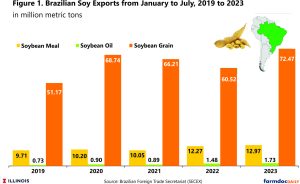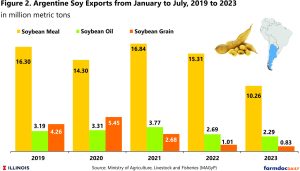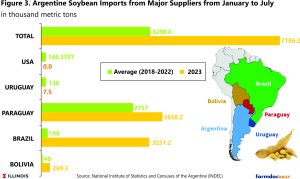Brazilian farmers harvested almost 160 million tons of soybeans in the last crop season, resulting in record exports in the first seven months of 2023. Price competitiveness led to a significant increase in the volume of oilseed shipped to China. Brazil also benefited from sales to a nation not usually on its soybean-customer list: Argentina.
The third-largest soybean producer behind Brazil and the United States, Argentina suffered nearly a 50% crop decline because of drought. In order to meet its crushing-industry contracts for soybean oil and meal, the nation purchased Brazilian soybeans and, as a result, temporarily became the second-leading destination for Brazilian soybeans after China. Also, Argentina is losing its top position as soybean meal exporter this season, giving up its place to Brazil.
Brazil’s Record Pace Shows No Signs of Slowing
Brazilian soybean exports totaled 72.47 million tons in the first seven months of 2023, an increase of 20% compared to the same period last year, according to the Brazilian Foreign Trade Secretariat, SECEX (see Figure 1). The increase was driven mainly by China, which bought 69% of Brazilian soybean exports in this period. From January to July 2023, Brazil’s soybean exports to China rose to an all-time high of 50.4 million tons, a 25% increase from the same period in 2022


Chinese soybean imports are expected to remain high in the last quarter of the year as the world’s top buyer sources competitively priced soybeans from South America. The U.S. Department of Agriculture (USDA) raised its estimate of 2022/23 (October-September) China soybean imports to a new record of 100 million tons. Through 10 months of the current marketing year, China has imported nearly 84.5 million tons of soybeans, 59% from Brazil and 30% from the United States (USDA, 2023).
Beyond the Chinese demand, Brazilian soybean exports have soared because of the severe drought affecting the soybean crop during the last growing season in Argentina. Brazilian government data show that from January to July, Brazil sold 3.5 million tons of soybeans to Argentina, putting the commodity at the top of the list of Brazilian products sold to its neighbor. The number of soybeans exported this year is more than 15 times the total amount of soybeans exported to Argentina during the same period last year.


Argentina Imports Soybeans to Feed Its Industry
In the 2022/2023 crop year, extreme drought affected the entire soybean-producing area in Argentina. Production was just 46% of the average production of the previous five harvests. Argentina saw its crop decline to 25 million metric tons in 2022/23, according to data from the USDA. Argentina’s Rosario Grains Exchange estimated an even smaller harvest, closer to 20 million metric tons.


The drought in Argentina had a significant impact on the flow of soybeans in South America. From January to July 2023, Argentina imported 7.19 million tons in order to fulfill contracts already signed for soybean oil and meal, more than double the average in the last five years (see Figure 3). Temporary soybean grain imports from Brazil increased sixteen-fold in the first seven months of 2023 compared to the same period, while soybean grain imports from Paraguay grew 33%. However, there were few soybean grain imports from Uruguay, which had been a source in previous years. Uruguay, along with Argentina, were the South American nations most affected by the most recent drought. The total soybean imports by Argentina this year are expected to reach 9 million tons.
Argentina has been among the leading exporters of soybean meal and oil for more than two decades. However, projections from the Rosario Grain Exchange indicate that Argentina is losing its top position as soybean meal exporter this season, giving up its place to Brazil, which has exported 20% more soybean meal volume than Argentina between January and July. In this period, Brazil exported 12.97 million tons of soybean meal; Argentine shipments totaled 10.26 million tons (see Figure 1 and 2).
Summary
The drought in Argentina in the last crop season had a significant impact on soybean grain trade in South America. Argentina became the second-leading destination for Brazilian soybeans in the first seven months of 2023, behind China. Temporary soybean imports from neighboring countries allowed Argentina to maintain part of its export business of soybean meal and oil. In addition to the unusual exports to Argentina, Brazil recorded all-time high shipments to China. China is likely to continue importing more soybeans from Brazil and possibly less from the United States, as the price of American crops have been rising due to decreasing supply expectations, while Brazil’s output prospects remain strong and attractive. Also, China tends to buy more soybeans from Brazil than the United States for geopolitical reasons.
Source: illinois.edu













